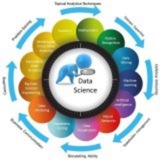Forwarded from Data Science | Machine Learning with Python for Researchers
#DataScience #MachineLearning #DeepLearning #Python #AI #MLProjects #DataAnalysis #ExplainableAI #100DaysOfCode #TechEducation #MLInterviewPrep #NeuralNetworks #MathForML #Statistics #Coding #AIForEveryone #PythonForDataScience
Please open Telegram to view this post
VIEW IN TELEGRAM
👍7❤5🔥4
Data Science Machine Learning Data Analysis
Photo
# 📚 PyTorch Tutorial for Beginners - Part 6/6: Advanced Architectures & Production Deployment
#PyTorch #DeepLearning #GraphNNs #NeuralODEs #ModelServing #ExplainableAI
Welcome to the final part of our PyTorch series! This comprehensive lesson covers cutting-edge architectures, model interpretation techniques, production deployment strategies, and the broader PyTorch ecosystem.
---
## 🔹 Graph Neural Networks (GNNs)
### 1. Core Concepts

Key Components:
- Node Features: Characteristics of each graph node
- Edge Features: Properties of connections between nodes
- Message Passing: Nodes aggregate information from neighbors
- Graph Pooling: Reduces graph to fixed-size representation
### 2. Implementing GNN with PyTorch Geometric
### 3. Advanced GNN Architectures
---
## 🔹 Neural Ordinary Differential Equations (Neural ODEs)
### 1. Core Concepts

- Continuous-depth networks: Replace discrete layers with ODE solver
- Memory efficiency: Constant memory cost regardless of "depth"
- Adaptive computation: ODE solver adjusts evaluation points
#PyTorch #DeepLearning #GraphNNs #NeuralODEs #ModelServing #ExplainableAI
Welcome to the final part of our PyTorch series! This comprehensive lesson covers cutting-edge architectures, model interpretation techniques, production deployment strategies, and the broader PyTorch ecosystem.
---
## 🔹 Graph Neural Networks (GNNs)
### 1. Core Concepts

Key Components:
- Node Features: Characteristics of each graph node
- Edge Features: Properties of connections between nodes
- Message Passing: Nodes aggregate information from neighbors
- Graph Pooling: Reduces graph to fixed-size representation
### 2. Implementing GNN with PyTorch Geometric
import torch_geometric as tg
from torch_geometric.nn import GCNConv, global_mean_pool
class GNN(torch.nn.Module):
def __init__(self, node_features, hidden_dim, num_classes):
super().__init__()
self.conv1 = GCNConv(node_features, hidden_dim)
self.conv2 = GCNConv(hidden_dim, hidden_dim)
self.classifier = nn.Linear(hidden_dim, num_classes)
def forward(self, data):
x, edge_index, batch = data.x, data.edge_index, data.batch
# Message passing
x = self.conv1(x, edge_index).relu()
x = self.conv2(x, edge_index)
# Graph-level pooling
x = global_mean_pool(x, batch)
# Classification
return self.classifier(x)
# Example usage
dataset = tg.datasets.Planetoid(root='/tmp/Cora', name='Cora')
model = GNN(node_features=dataset.num_node_features,
hidden_dim=64,
num_classes=dataset.num_classes).to(device)
# Specialized DataLoader
loader = tg.data.DataLoader(dataset, batch_size=32, shuffle=True)
### 3. Advanced GNN Architectures
# Graph Attention Network (GAT)
class GAT(torch.nn.Module):
def __init__(self, in_channels, out_channels):
super().__init__()
self.conv1 = tg.nn.GATConv(in_channels, 8, heads=8, dropout=0.6)
self.conv2 = tg.nn.GATConv(8*8, out_channels, heads=1, concat=False, dropout=0.6)
def forward(self, data):
x, edge_index = data.x, data.edge_index
x = F.dropout(x, p=0.6, training=self.training)
x = F.elu(self.conv1(x, edge_index))
x = F.dropout(x, p=0.6, training=self.training)
x = self.conv2(x, edge_index)
return F.log_softmax(x, dim=1)
# Graph Isomorphism Network (GIN)
class GIN(torch.nn.Module):
def __init__(self, in_channels, hidden_channels, out_channels):
super().__init__()
self.conv1 = tg.nn.GINConv(
nn.Sequential(
nn.Linear(in_channels, hidden_channels),
nn.ReLU(),
nn.Linear(hidden_channels, hidden_channels)
), train_eps=True)
self.conv2 = tg.nn.GINConv(
nn.Sequential(
nn.Linear(hidden_channels, hidden_channels),
nn.ReLU(),
nn.Linear(hidden_channels, out_channels)
), train_eps=True)
def forward(self, data):
x, edge_index = data.x, data.edge_index
x = self.conv1(x, edge_index)
x = F.relu(x)
x = self.conv2(x, edge_index)
return x
---
## 🔹 Neural Ordinary Differential Equations (Neural ODEs)
### 1. Core Concepts

- Continuous-depth networks: Replace discrete layers with ODE solver
- Memory efficiency: Constant memory cost regardless of "depth"
- Adaptive computation: ODE solver adjusts evaluation points
❤2
📌 Introducing ShaTS: A Shapley-Based Method for Time-Series Models
🗂 Category: DATA SCIENCE
🕒 Date: 2025-11-17 | ⏱️ Read time: 9 min read
Explaining time-series models with standard tabular Shapley methods can be misleading as they ignore crucial temporal dependencies. A new method, ShaTS (Shapley-based Time-Series), is introduced to solve this problem. Specifically designed for sequential data, ShaTS provides more accurate and reliable interpretations for time-series model predictions, addressing a critical gap in explainable AI for this data type.
#ExplainableAI #TimeSeries #ShapleyValues #MachineLearning
🗂 Category: DATA SCIENCE
🕒 Date: 2025-11-17 | ⏱️ Read time: 9 min read
Explaining time-series models with standard tabular Shapley methods can be misleading as they ignore crucial temporal dependencies. A new method, ShaTS (Shapley-based Time-Series), is introduced to solve this problem. Specifically designed for sequential data, ShaTS provides more accurate and reliable interpretations for time-series model predictions, addressing a critical gap in explainable AI for this data type.
#ExplainableAI #TimeSeries #ShapleyValues #MachineLearning
